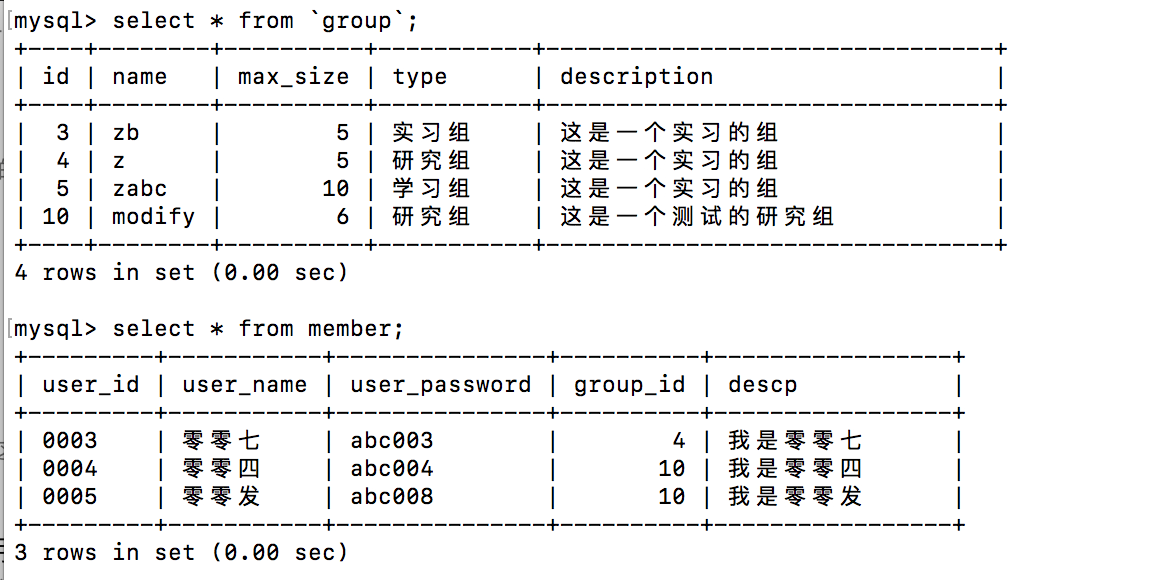Previous review
- order by
select * from `group` order by max_size;
select * from `group` order by max_size desc;- Query number (limit)
select * from `group` limit 2;
select * from `group` limit 2,3;- Sorting and Query Quantity Combination
select * from `group` order by max_size limit 2;- group by
select max_size,count(*) from `group` group by max_size;- Fuzzy query (like)
select * from `group` where name like '%b%';
select * from `group` where name like 'z_';- Detailed explanation of foreign keys
If you have doubts about the above, you can check it out Last blog
Subquery
The missing distinct
The Type of Maximum Number of Query Groups
select distinct max_size from `group`;
having
Usage: Same as where
Difference: where is used to query data, and having is mainly used to filter query data.
/* View Grouping Types with Number of Grouping Types greater than 1 */
select type,count(*) from `group` group by type having count(*) >1;
where sub-query
/* Get the largest number of groupings */
select * from `group` order by max_size desc limit 1;
/* Using subqueries */
select * from `group` where
max_size = (select max(max_size) from `group`);in subquery
Query Grouping Numbers 3, 4, 5 Grouping
select * from `group` where id in (3,4,5);
between ... and ...
If the interval is large, consider using this
select * from `group` where id between 3 and 5;
multi-table query
Groups that do not have members in query groupings
select * from `group` where id not in
(select group_id from member group by group_id);

Query results use multi-table data
Query all users and display other data such as the name of their group
select m.user_id,m.user_name,m.user_password,m.descp,
g.id,g.name,g.max_size,g.type,g.description
from member m,`group` g where m.group_id = g.id;
from member m,group g: where m and G denote aliases for member and group tables respectively, this sql statement may be a bit long if aliases are not used
Note the last query condition.
You can try if you don't write conditions.
select m.user_id,m.user_name,m.user_password,m.descp,
g.id,g.name,g.max_size,g.type,g.description
from member m,`group` g ;
It is obvious that there are 12 records. At this time, group has 4 data and member has 3 data. So it is self-evident how the 12 records came into being.
left join query on...)
Left join query: The first table in the two tables prevails and null if no second data exists
An online tool to beautify sql statements: sql beautify
SELECT g.id, g.name, g.max_size, g.type, g.description
, m.user_id, m.user_password, m.descp
FROM `group` g
LEFT JOIN member m ON g.id = m.group_id;
right join query on...)
Return to the right table if there is no data in the left table.
SELECT g.id, g.name, g.max_size, g.type, g.description
, m.user_id, m.user_password, m.descp
FROM `group` g
RIGHT JOIN member m ON g.id = m.group_id;
full join query on...)
Return columns as long as one table matches successfully
inner join... on...)
Only if both tables match successfully will the column be returned
SELECT g.id, g.name, g.max_size, g.type, g.description
, m.user_id, m.user_password, m.descp
FROM `group` g
INNER JOIN member m ON g.id = m.group_id;
mysql has completed this series of blogs. If you have any other suggestions, you can leave a message.
Welcome to your message reprint
Focus on Wechat Public Number: SimFG, Read Blog Points anytime, anywhere 